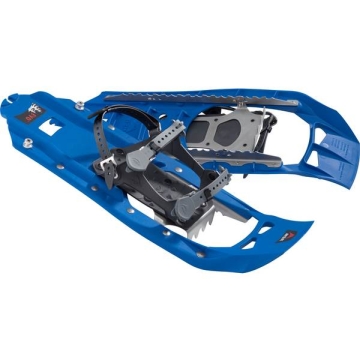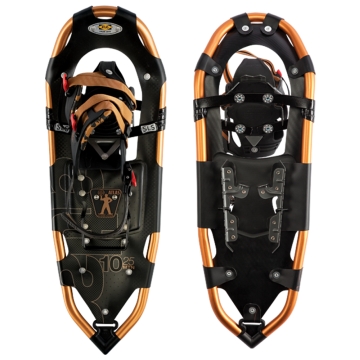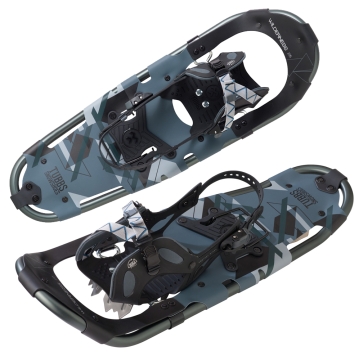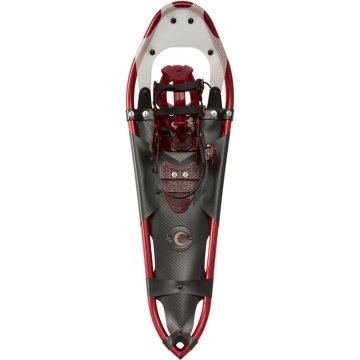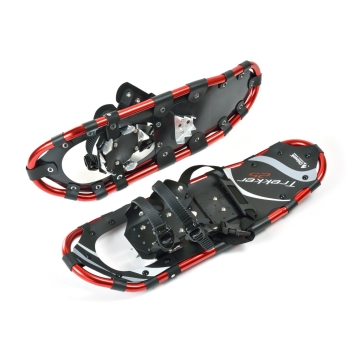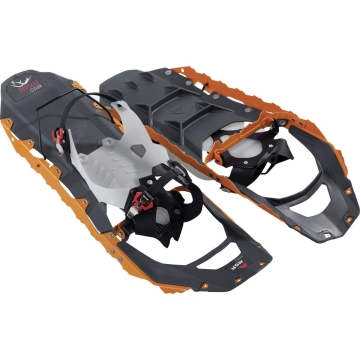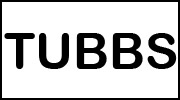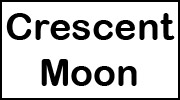From flat terrain to steep slopes. From groomed trails to fluffy deep powder. The best of snowshoes allow you to explore the vast winter wonderland with ease: no more post-holing, no more tumbling down, and no more cramp-inducing awkwardness. The question is which one is the perfect snowshoe for you.

Unleash the thrill of winter exploration with the best snowshoes for every adventure!
Navigate snow-covered trails with confidence and discover the beauty of winter landscapes. Whether you’re a seasoned hiker or a curious beginner, our guide unveils the top-rated snowshoes to elevate your winter expeditions.
Dive into our comprehensive buying guide to make informed decisions and find the perfect snowshoes for your needs. Explore diverse terrains, discover essential features, and embrace the magic of winter adventures!
Best Snowshoes 2024
| Snowshoes | Best For | Type | Size | Price |
|---|---|---|---|---|
| MSR Lightning Ascent |
| Backcountry | 22", 25", 30" | $$$ |
| Tubbs Mountaineer |
| Backcountry & Recreational | 25", 30", 36" | $$$ |
| MSR Evo |
| Recreational | 22" | $ |
| Atlas Race Snowshoes 7075 |
| Running | 22" | $$$$ |
| Atlas 10 Series Snowshoes |
| Recreational | 25", 30", 35" | $$ |
| Tubbs Wilderness |
| Recreational | 22", 25", 30" | $$ |
| Atlas Elektra Montane |
| Backcountry | 23", 27" | $$$ |
| Crescent Moon Gold 10 |
| Backcountry & Recreational | 32" | $$$ |
| Chinook Trekker Snowshoes |
| Recreational | 19", 22", 30", 36" | $ |
| MSR Revo Explore |
| Backcountry & Recreational | 22", 25" | $$ |
In most cases, affordable recreational snowshoes like MSR Evo is good enough for first-time snowshoers. It’s lightweight and equipped with decent traction systems that allow the wearer to travel groomed trails and moderate rolling terrain with ease. However, if you hope to blaze your way through the off-trails–exploring the quiet and remote backcountry drifts–you’re going to need advanced backcountry snowshoes like MSR Lightning Ascent or Tubbs Mountaineer.
Another important thing to note is the size or length of the snowshoes. In case you wonder, yes, all of these snowshoes are available in a number of sizes. You have to take your weight load into account to choose the proper length of your snowshoes. For more info about this, you can head to our specific post about the snowshoe sizing guide.
MSR Lightning Ascent – Best Backcountry Snowshoes
What’s Hot: Ultralightweight, remarkable traction, great flotation.
What’s Not: Straps-in feature not user-friendly.
Best Applications: Technical steep terrain, deep snow, advanced backcountry off-trails
MSR Lightning Ascent has been the favorite snowshoes of many winter explorers for quite some time now. With its precisely designed frames and advanced traction systems, it’s not hard to agree that it’s the best snowshoes for backcountry exploration. The decking is constructed of lightweight nylon, weighing in no more than 4-pounds overall. It’s arguably one of the lightest snowshoes ever made, which is exactly what you need if you wish to travel over long distances or steep hills.
The wide oval frames of MSR Lightning Ascent offer an outstanding flotation in powdery situations. It won’t be much of a handicap too should you wear it on groomed trails and hard-packed snow; thanks to the lightweight design. As for the traction, you need not doubt it the slightest. With big underfoot crampons that work together with heel brakes and a series of cleats running along its outer frames, it’s safe to say that it’s the grippiest snowshoes there is currently.
Tubbs Mountaineer – Best Snowshoes for All Terrain

What’s Hot: Good for both recreational and backcountry trekking, comfortable bindings, unmatched flotation.
What’s Not: Heavy and bulky
Best Applications: Groomed trails, intermediate to advanced backcountry terrain, deep snow
Tubbs Mountaineer is actually meant to be backcountry-oriented snowshoes, just like MSR Ascents. However, the less technical traction systems allow for more efficient movement on a moderate rolling terrain, making it also ideal for recreational use. For beginners, Tubbs Mountaineer can be an interesting option too since these snowshoes incorporate a binding that’s presumably the easiest and the most comfortable in comparison to the typical models. The twin straps are supported by a panel that covers your forefoot. It’s not only comfortable but very secured too.
Tubbs Mountaineer is the only snowshoes available in the size of 36-inch, which is the longest of all. This can be great if you like to travel with huge weight loads, or if you yourself are a big person. In terms of flotation, these snowshoes also fare among the highest. Unfortunately, Tubbs Mountaineer is a tad on the heavy side (5 pounds, more or less). So, if you have regular to small figure, you may have to struggle a bit as you stride with them attached on your boots.
Shop now at Amazon.comMSR Evo – Best Budget Snowshoes for Beginners
What’s Hot: Affordable, lightweight, versatile, good traction, user-friendly bindings
What’s Not: Available only one size
Best Applications: Beginner trails, groomed or packed snow, intermediate slopes
For those of you who are looking to get your first experience exploring winter trails with snowshoes, you’d have your best shot going with MSR Evo. It’s far more affordable than the previous two models. It’s lightweight, and best of all, it performs surprisingly well in many different snow conditions. The traction isn’t all that bad either. The crampons beneath the front foot look pretty solid, and yet, it’s still equipped with lateral side rails made of steel. That’s more than enough grip to help you wander around moderate slopes safely.
The frames and decking are made of one part. They dub it as UniBody construction. It’s all plastic: lightweight and sturdy but can make quite some noise when used on hardpack snow. Another thing to note is MSR Evo is only available in one size, 22-inch. With such length, you will have a hard time exploring soft powder with these snowshoes. The good news is it’s compatible with add-on flotation tails that give it an additional 6-inch length.
Shop now at Amazon.comAtlas Race Snowshoes 7075 – Best Snowshoes for Running/Racing
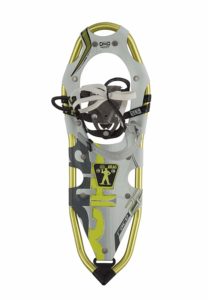
What’s Hot: Spring loaded suspension, racing bindings
What’s Not: Very costly
Best Applications: Running, fitness
The requirement to make the best running snowshoes is entirely different from that of typical backcountry snowshoes. Not only must it offer good flotation, but it also must be lightweight and compact to allow for efficient and unrestrained movement on the snowy tracks. Atlas Race Snowshoes 7075 are made with this specific use in mind. The only shortcoming about it is probably the high price tag.
Atlas Race Snowshoes 7075 are very popular among snow runners. Sporting an all-carbon construction, these ultralight snowshoes won’t drag your feet down as you run on the winter trails. Their long frames are combined with Atlas spring-loaded suspension (SLS) to keep the snowshoe close underfoot for easy maneuverability. To keep weight low but traction high, these Atlas snowshoes are built with titanium toe and heel crampons. Their design allows you to mount your running shoes right to the decks.
Shop now at Amazon.comOther Top Rated Snowshoes
Atlas 10 Series Snowshoes
What’s Hot: Nimble on hardpack, lightweight, secure, good traction for flat to rolling terrain
What’s Not: Difficult bindings, not enough flotation for deep snow
Best Applications: Hardpack, groomed trails, rolling hills, intermediate terrain
Atlas 10 Series snowshoes are an excellent choice for beginner to intermediate snowshoers. Sporting fixed rotation bindings, these snowshoes are very easy to move on hardpack, making them ideal for trail walking, day hiking, and hut trips. The rubbery webbing straps that connect the platform with the boot attachment are flexible and create a spring-like effect as you step. The result is nimble snowshoes that respond well to fast walking. Still, about the bindings, the straps and plastic pad that secure your boots in these snowshoes are a bit of hassle to deal with, initially. They tend to curl in, requiring more work from your end. Luckily, once they’re set, they stay secure the whole time.
Atlas 10 Series snowshoes come with three size options: 25, 30, and 35 inches. They feature the company’s trademark V-shaped frames with tapering tails at the back. They do not drag snow as you move forward but have a tendency to fling snow at your back. As for the traction, these snowshoes easily knock out any competing models. Despite being labeled as flat terrain snowshoes, you can take them to climb some moderate slopes in the backcountry. The crampons work well at gripping uneven surfaces, ensuring a safe and relatively easy ascent for you. Just make sure you don’t climb a very steep incline, though.
Shop now at Amazon.comTubbs Wilderness
What’s Hot: Easy-to-use bindings, comfortable for traveling with a loaded pack
What’s Not: Heavy decking material seems cheap, stiff for hardpacked snow
Best Applications: Winter backpacking, beginner trails, moderate backcountry
Tubbs Wilderness is a perfect choice if you want to step up from the novice-friendly groomed trails to a more challenging rolling terrain. Featuring easy-to-use bindings, these snowshoes should be exciting for beginners to intermediate winter hikers. The combination of Soft Tec decking with oval aluminum frames feels a bit heavy, but they do provide good enough flotation on knee-deep soft powder. You won’t likely find yourself post-holing as you walk with them. However, if you want to enjoy the best flotation in deep snow, go with Tubbs Mountaineer.
Tubbs Wilderness is equipped with semi-aggressive crampons fixed at the bottom of your feet balls. The supporting side rails bite the snow firm enough to provide you with traction as you make a cross over moderate slopes. The thing where they excel the most is stability. If you’d like to spend some night on the outside with your loaded backpack, Tubbs Wilderness is the best snowshoes for you.
Shop now at Amazon.comAtlas Elektra Montane Mountain Hiking Snowshoes
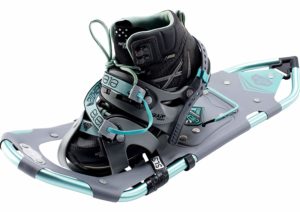
What’s Hot: V-frame, comfortable binding, spring-loaded suspension
What’s Not: Expensive
Best Applications: Intermediate terrain, rolling hills, back-country
Atlas Elektra is a series of snowshoes built specifically for women. Now, these snowshoes have many different iterations. Each of which comes with different specifications and prices. They’re mainly intended for backcountry trekking on the beaten path off-trails. However, they’re comfortable enough to be used on groomed snow. Thanks to the lightweight design.
If you don’t like the steep price tag of Elektra Montane Mountain, the Elektra 12, Elektra 10, and Elektra 9 offer similar functionality for much less. They still sport the proprietary lightweight V-frames that are long enough to provide flotation on powdery terrain but not that long to trouble you with each step. After all, they’re designed for women who generally have a shorter stride than men. The V shape frames track straight in deep snow, and the tapered tail pulls less snow as you step forward, saving you energy.
Shop now at Amazon.comCrescent Moon Gold 10
What’s Hot: Made in the USA, lifetime warranty, good traction systems, user-friendly bindings
What’s Not: Expensive
Best Applications: Deep snow, off-trails, backcountry trip
Crescent Moon snowshoes are relatively more expensive compared to the competition, but that’s not for no reason. Putting big emphasize on quality, all of the parts on Crescent Moon snowshoes are manufactured and built in the USA. Largely, they’re grouped into two models: the Silver and Gold series. The number behind them actually reflects the size of the snowshoes. Just in case you need smaller or bigger snowshoes, the greater the number, the bigger the snowshoes are.
The Crescent Moon Gold 10 have a length of 33-inch that works great for maximum weight loads of 225 pounds. They’re designed primarily for backcountry trips over some technical rolling terrains. Still, since they adopt teardrop-shaped frames with the tails tapering at the close, they should be nimble enough for recreational snowshoeing on groomed trails and packed snow. The crampons, though made of solid stainless steel, are not as grippy as the MSR Lightning Ascent, but they’re still among the best you can find.
Shop now at Amazon.comChinook Trekker Snowshoes
What’s Hot: Affordable, lightweight, durable plastic decking
What’s Not: Aluminum crampons are easy to bend, no side rails
Best Applications: Recreational snowshoeing, on-trails, soft snow
Chinook might not be the first brand that pops up into your mind when it comes to snowshoeing, but it manufactures one of the best inexpensive snowshoes today. While they lack technical features like lateral crampons and high-quality nylon decking, the Chinook Trekker Snowshoes will certainly do well enough for principal time snowshoers. Available in various sizes, they are an ideal choice for both kids and adults who are looking to enjoy a fun short trip on the nearby trails.
The bindings on Chinook Trekker Snowshoes are perfect for beginners. They’re easy to take on and off quickly, which is exactly what you need if you’re a novice in snowshoeing. The decking is made entirely of plastic, but it doesn’t seem to be cheap at all. As for the traction, they come with semi-aggressive underfoot crampons along with V-shaped heel brakes. That’s clearly insufficient to tackle steep hills, but you’ll do just fine with them on-trails.
Shop now at Amazon.comMSR Revo Explore
What’s Hot: Aggressive underfoot and side crampons, solid construction, heel lifts
What’s Not: Binding systems seemingly not secure enough
Best Applications: Groomed trails, packed snow, moderate rolling terrain, deep snow
For those who think that the traction on MSR Lightning Ascent is too much, MSR Revo Explore is the right snowshoes for you. They sport the same aggressive lateral crampons that go along the outer frame, together with two major teeth under the toes and your feet balls. With them, you’d still have enough traction to explore literally any traverse on the off-trails. However, since the heel crampons are non-existent in this model, you need to be more careful on the downhills. The good news is since they’re stripped of the heel crampons, you can expect it to come at a much lower price.
MSR Revo Explore is available in two sizes: 22-inch and 25-inch. That might not be long enough to make you stay afloat in deep snow, especially if you bring your backpack. Still, it’s compatible with the optional add-on tails that should significantly improve the flotation. The bindings on this snowshoes consist of the regular back heel strap with only one strap that goes over your front feet. While it’s fast and very easy to adjust, it’s not as secure as those of the higher models.
Shop now at Amazon.comSnowshoes Buyer Advice
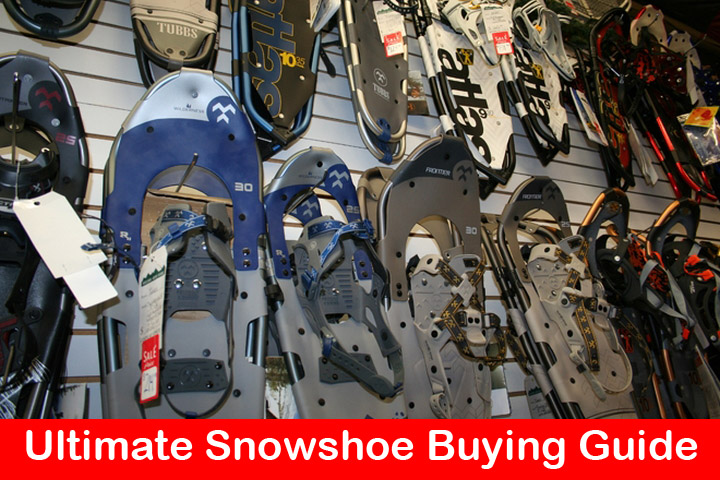
Types of Snowshoes
As far as the specification goes, snowshoes can be classified into three: recreational snowshoes, backcountry snowshoes, and running snowshoes. Recreational snowshoes can be further differentiated in two: budget snowshoes and mid-range snowshoes. To know which snowshoes are the best for you, you will need to map the various kinds of terrain you’ll tackle. Let’s break them down one by one.
- Groomed and Flat Terrain: Budget Snowshoes. If you are just going to cover nearby groomed terrain, which is mostly flat all the way, good budget snowshoes should be enough for you. Their size is not very big but provides enough flotation that allows you to move nimbly on groomed trails. The traction is also kept to a minimum, and bindings are designed to be very user-friendly.
- Rolling Terrain: Mid-range Snowshoes. A step-up from the previous is mid-range snowshoes. They’re designed to help casual hikers tackle moderately sloping terrain with knee-deep in powder. They feature a refined frame to promote better flotation over soft snow. The crampons are slightly more aggressive too, enabling you to walk over rolling hills, more confidently.
- Steep Terrain with Deep Snow: Backcountry Snowshoes. They’re generally designed for more advanced hikers and snowshoers who like to make their way through off-trail backcountry tracks. They’re considerably larger than recreational snowshoes to provide maximum flotation. The traction device underneath is also more advanced to help tackle steep terrain with ice on high altitude. Often, they’re also equipped with heel lifts to help you walk better on sharp inclines.
You see, there is a lot of different types of snow. There will be times when you’re bound to tackle various types of terrain in one go. In this case, you will need to make a priority list. Start thinking of the terrain that seems to be the most difficult to cover. Or, you can prioritize the one that dominates your travel, and pick out the snowshoes that match it best. Whenever you’re in doubt, keep this in mind: it’s always better to hit the trails with too-good snowshoes than wearing the one that seems ideal for a certain condition but put you in an awful handicap on another.
Running Snowshoes
The name says it all. Running snowshoes are aimed for regular runners and joggers who like to expand their routine in snowy winter. Many of them are made of premium lightweight carbon composite, so they won’t put too much weight on the wearer. The bindings and traction device are designed to be special too. They enable the wearer to move quickly and comfortably, while also providing good security to minimize the risk of getting slipped.
Snowshoes Size Chart
The second most essential thing in determining which snowshoes are best for you is the size. Generally speaking, the heavier your weight load, the longer snowshoes you will need. This weight load here counts as personal bodyweight plus whatever things you carry, like a backpack, water, etc. Snowshoes with the right size will provide you with optimal flotation, keeping you above light snow as you walk on it. Snowshoes that are too small will not help you avoid post-holing in deep snow, exhausting you way too quickly. On the other hand, snowshoes that are too bulky will only act as an added hindrance on your feet.
Snowshoe manufacturers usually offer a size chart that tells you which length is best for you. Still, in case you’re missing one, you can use the following.
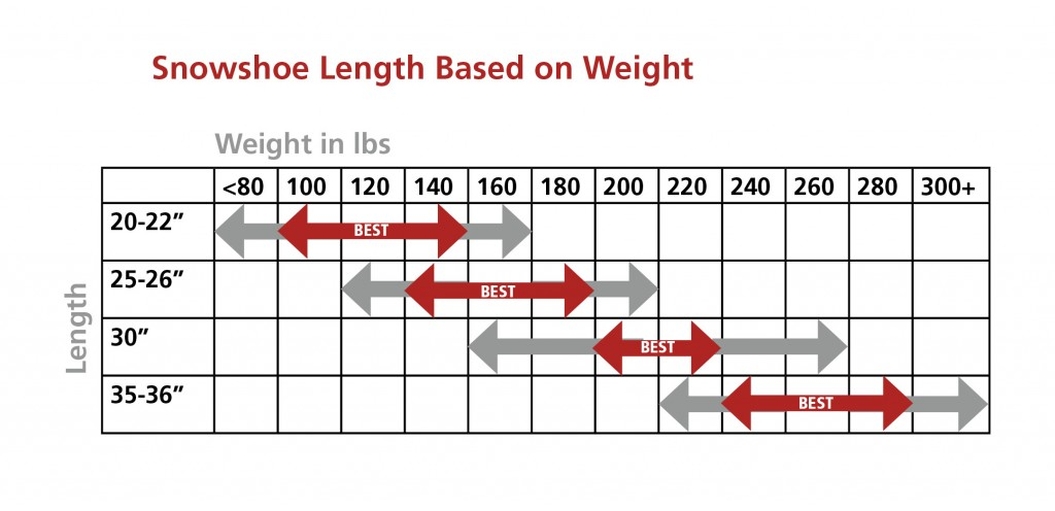
Snowshoes for Women
Except for a brighter splash of color, there wasn’t anything that distinguished women’s snowshoes from their men’s (unisex) counterpart. Manufacturers didn’t see the need to make any special adjustments for female snowshoers. Fortunately, this has changed in recent times. Snowshoes for women have been improved to accommodate both the physical and behavioral differences of women.
Firstly, instead of boasting the same standard length of 25-inch, women’s snowshoes are shortened to 23-inch. This reduces the weight without necessarily compromising the flotation. Furthermore, the frame shape has also been adjusted, narrowing at the back of the snowshoe. In addition, since women’s footwear are generally smaller, the bindings have been modified as well. To sum it up, if you’re looking for women’s snowshoes, do not go for the unisex model unless you’re more on the big side.
Snowshoes for Kids
Seeing there aren’t many things to do for children in winter, manufacturers also begin to expand their offering to the kid market. Today, you can buy a pair of good snowshoes designed specifically for children. Commonly, they’re low on features but more than enough to help your children move on the snow-covered tracks. The bindings are designed to be simple too so they can be taken off and on with ease. Pricing is pretty good as well. With only a few features, you can buy snowshoes for kids for cheap.
Top Snowshoe Brands
It doesn’t matter how much we try to be objective, there are always particular brands that pop up quickly into our minds when it comes to snowshoeing. MSR, Tubbs, Atlas, and Crescent Moon are all reputable snowshoe makers that successfully make their own names among many winter sports enthusiasts. Their snowshoes are all of high quality and excellent performance. Click the brand name below to find out the best snowshoes coming out of their respective factories.
Snowshoes Structure
The snowshoes’ structure can be broken down into two common parts: the primary and additional parts. The primary parts of a snowshoe comprise of frame and decking, bindings as well as underfoot crampons. The additional parts, on the other hand, include heel lifts, add-on flotation tails, and braking bars. Understanding these parts may lead you to a successful purchase of best snowshoes.
Frame
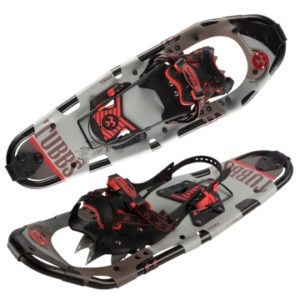
Traditional snowshoes utilize wood as their frame. Today, however, the majority of them, if not all, have the frame constructed of steel and aluminum. The higher-end snowshoes (primarily used for racing and running), in fact, have step it up a notch by incorporating lightweight yet durable materials such as carbon fiber and composite plastic.
As far as the shape goes, you can either opt for snowshoes with a large oval frame or one with a tapered tail. Such differences affect how the snowshoes perform on the trails. Oval shaped frames are best for optimal flotation and stability. That’s why it’s frequently used on many backcountry snowshoes intended to cover off-trails with deep snow. In contrast, the tapered frames are often lighter in weight, aiding the wearer to move more efficiently on flat groomed trails. For that reason, they’re commonly used for women’s snowshoes and running snowshoes.
Decking
The decking is the part on which you place your feet. In the past, this part was made of rawhide webbing, which is not practical as it requires a good deal of maintenance and is rather short-lived. Fast forward to the present, snowshoes decking now features various kinds of synthetic materials, such as PVC-coated polyester, thermoplastic urethane, etc. Not only are they durable but also convenient as they require less even no maintenance at all. Some advanced snowshoes like MSR Evo have their frame and decking made of one integrated part, which improves its sturdiness.
Crampons
Crampons provide traction for the snowshoes so that the wearers don’t slip easily on packed snow or icy tracks. Depending on the terrain application, the aggressiveness of snowshoe crampons vary. Recreational snowshoes for flat trails usually feature a moderate crampon located under your toes or the ball of your feet. Some are also equipped with heel crampons for added traction on descents. The most advanced traction system on snowshoes utilizes the aforementioned two and is further backed up by lateral crampons. These are a series of rigid teeth that stretch at the side of the outer frame. You hardly need them, unless you plan on a serious backcountry getaway on some steep hills in high altitude where icy slick terrain dominates the area.
Bindings
Snowshoe bindings often come in the form of strap-in systems that go over your feet and around your heels. Common materials are nylon, plastic, and rubber band-like straps. The function is to secure your boots to the snowshoes. Now when it comes to snowshoe bindings, there are two primary styles. Each of them offers its own merits and shortcomings.
- Rotating Bindings: This kind of snowshoe bindings utilize a pivot that rotates up to 90-degree or more as you stride. The idea is to enable the wearer to perform a wider range of motion when walking on the snow. This will cast more snow away from your feet, hence, minimizing leg fatigue. The shortcoming is it’s not easy to step backward with a binding that keeps swiveling. Anyway, rotating bindings are common in backcountry snowshoes, in which ideal application is in steep terrain.
- Fixed Bindings: This type of snowshoe bindings are connected to a durable rubber band that goes beneath the front foot. It secures the entire snowshoes to your feet, hence, requiring you to lift your leg higher to make a step. You will likely kick up some snow with each step, and that will exhaust you more quickly. However, the good thing about it is it’s much easier to move fast and make longer stride with fixed bindings. That’s why running snowshoes often incorporate this type of bindings.
Additional Features
- Heel Lift Bars: It’s a metal bar that stays flat under your heel and can be flipped to add support while you’re going uphill. On a steep terrain where the ascents are quite long, heel lift can be very useful as it reduces the strain on your calf muscle and also your ankle. They’re mostly found in advanced backcountry snowshoes.
- Braking Bars: Many snowshoes with plastic decking has this feature underneath. They act as supportive traction as you climb up steep inclines. That way, you won’t likely slip backward.
- Add-on Flotation Tails: A number of snowshoes, especially MSR, have a frame that’s compatible with add-on tail. This tail is usually 6-inch long and functions as a measure to improve the flotation. You can easily remove them when you travel on packed snow for more agility and attach them back for added flotation in deep powder.
What Makes the Best Snowshoes
The best snowshoes are not determined by the price. The most expensive snowshoes out there may pack loads of features, but they don’t necessarily make them perfect for you. You need to consider the type and size first. Once you make up your mind about those two, you need to take into account the following:
- Flotation: You will want snowshoes that give you maximum flotation on soft snow to avoid getting post-holed too early. It’s mainly influenced by the design of the snowshoes. Snowshoes with a wide, oval frame offer better flotation, but they can be quite heavy. Some manufacturers combine such a frame with tapered design at the back to trim down the weight, enabling you to be more agile.
- Traction: Much like the first one, the best snowshoes also need to offer maximum traction. Affordable recreational snowshoes often have only toe and heel crampons. Meanwhile, the more advanced models are also equipped with supportive underside traction devices, in addition to the main crampons. They will give you a nice firm grip on packed snow and icy terrain.
- Security: Snowshoes bindings and fit largely determine the security on your feet. Some snowshoes only fit a few types of footwear, while some others come with various fittings to accommodate a wide range of footwear. Once you find the right fit, the next thing to do is making sure it’s comfortable and easy to take on and off.
- Ease of Use: It may not seem as important as the previous three but you must not overlook it. Why? Because it can be very frustrating to have snowshoes with complex strap-in systems, when you know there’s a snowstorm hot on your tail and you get anxious to hit the tracks.
Best Snowshoe Boots
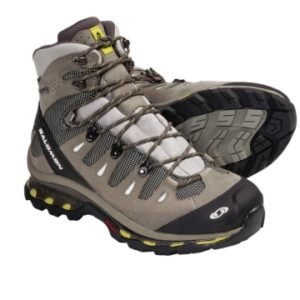
Although snowshoe bindings support a wide range of boots, it’s best if you go with either hiking boots or winter boots. If you decide on the first option, be sure to pick out the waterproof models, not the breathable ones. If possible, get the ones with Gore-Tex waterproofing, such as Salomon Quest 4D II GTX. They’ll provide better protection against the snow that might sneak in and soak your socks, leaving you with cold feet.
When the weather becomes a bit frosty, it’s a good idea to wear winter boots. Just make sure they’re adequately insulated and waterproof. You’re not going to deal with mud and slush when snowshoeing, but having waterproof winter boots will make sure that the moisture will stay out of your feet. Preferably, choose ones with rubber lower like Sorel boots. They’re tough, rugged, and more suitable for outdoor activity.
As for snowboarding boots, well yes, they are the most comfortable choice of all, and some snowshoes have large bindings that are compatible with them. However, many have proven to be too small for them, so I suggest you stick with those two. Here is a specific post where we cover the best boots for snowshoeing.
Poles and Gaiters

Given that snowshoeing is a very safe and easy activity, you won’t need to bring poles in most of your outing. However, having a good pair of them has its own merit. They help distribute the weight load and impact throughout your body, reducing the pressure on your knees and back. This is especially the case when you’re going uphill or crossing uneven traverses. By having poles with you, you minimize the risk of getting sore knees and stiff back at the end of your journey.
You don’t need to buy new poles. Simply use your good ol’ trekking poles, and swap the baskets with the ones made for soft powder, so they won’t sink when you stick them on the snow surface. You can get them for less than 10 bucks. If you want to buy new poles, however, we recommend getting telescoping aluminum poles with lever lock mechanism and, of course, powder baskets included. Black Diamond Ergo Trail is our favorite, but if you think it’s too pricey, here are our top 5 picks for best snowshoe poles.
Next to the poles, we also highly recommend you to wear gaiters. They act as extra protection for your boots, sealing the top opening, so snow won’t creep in and wet your socks. Crocodile Gaiters by Outdoor Research are an excellent choice. The material is completely waterproof but still allows for ample ventilation.
Why Choose Snowshoes?
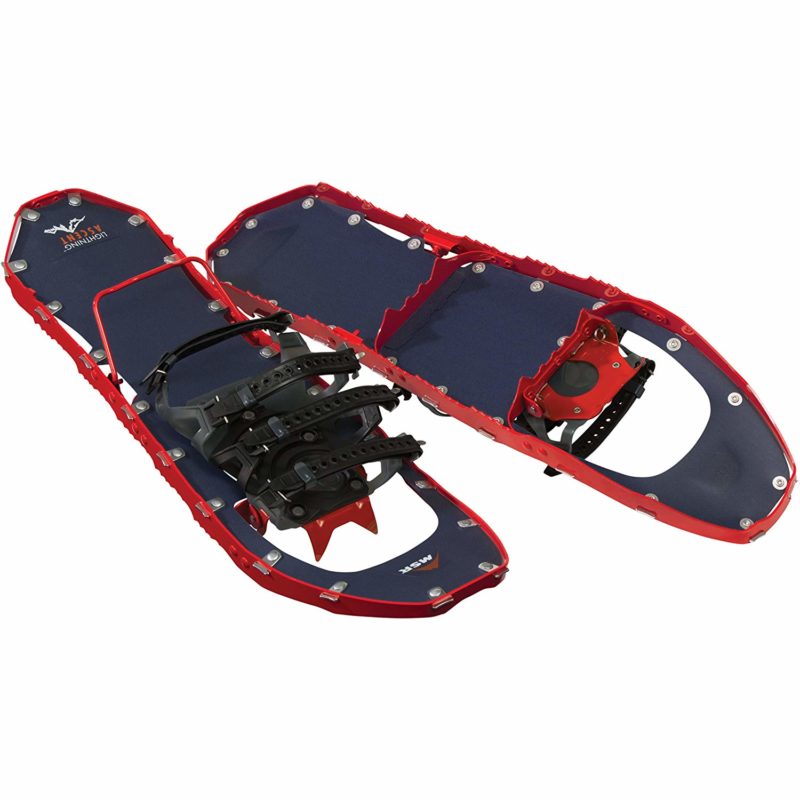
Generally speaking, snowshoes offer you three major advantages that can help secure fun and safe winter hiking experience. They are flotation, traction, and stability. Flotation refers to the ability of the snowshoes to prevent your feet from sinking down into powdered snow (deep snow). Without snowshoes, you’re going to forcefully pull your feet out of the snow in each step. Hikers call it as getting post-holed, a situation where you become very exhausted for getting your feet sunk in deep powder for too many times. It feels like walking with a bunch of solid bricks hanging on your feet.
The traction from snowshoes is provided by crampons, a set of metal claw devices attached at the bottom of almost all modern snowshoes. They will keep you from getting slipped on slippery areas caused by snow and thin ice. They give you the necessary grip to stop and go on both uphill and downhill travel. Now depending on the type of the snowshoes, their traction also differs accordingly. We will discuss this later.
Last but not least, snowshoes improve your stability while walking on uneven snow-covered terrain. The additional width and length from your snowshoes will help you get a firmer stance on any lopsided snowy trails. It’ll greatly reduce the risk of getting unwanted accidents like a sprained ankle.
Snowshoes Vs Skis and Split Boards
First thing’s first, snowshoes are far more affordable than skis and split boards. To give you the idea, the most advanced snowshoes by leading brands like MSR and Tubbs cost you less than 300 bucks, while skis can easily set you back at over $500. In fact, split boards can go all the way to $1,000. Also, as far as the learning curve is concerned, snowshoes win it completely. After all, not everyone can ski, but everyone can walk.
In terms of traction, snowshoes are also more superior than skis and split boards. Thanks to the integrated crampons. To be fair, skis and split boards are not with zero traction actually. You still can get a nice resistance when traveling uphill with those two if you have the skins (climbing skins). Unfortunately, most of them are sold separately, which means more cost on your end.
Still, on the defense of skis and split boards fans out there, I have to tell you that they are much more comfortable. With these two, you just need to glide your feet to move instead of lifting them, meaning you won’t be exhausted as quickly as when you wear snowshoes. Descending is also much faster as you just need to slide instead of walking.
I found an interesting discussion regarding how snowshoes compare to cross country skis. You can check it out here.
Snowshoes Vs Microspikes and Crampons
Unless you’re going to a full-blown mountaineering trip, you will very unlikely need microspikes and crampons. While they are excellent at providing traction for winter hiking, they offer zero flotation. They are designed to be used on trails with packed snow (hard snow) and ice. So, if you just want to go for recreational hiking or even a longer backcountry trip, your best shot is with snowshoes.

